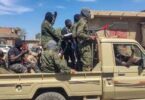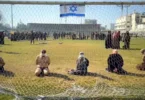Irina Alshaeva
Back in August, Defense Minister Sergei Shoigu announced the “enhanced development” of the military infrastructure in the Arctic, in the fall of 2021 large-scale exercises of the Northern Fleet were held in this region, at the end of December it was reported that the military would conduct firing here with a “modern missile defense complex”, which should intercept hypersonic target. Gazeta.Ru examined the progress of the military development of the Arctic by Russia and the United States.
The Russian Navy needs icebreakers
Russia took up the task of military development of the Arctic back in 2012 – after the United States issued the document “National Security Presidential Directive 66”.
“The directive indicates the intention of the United States to be present in the Arctic, including militarily. But it is due to the fact that the United States claims all the natural resources of the Arctic, so Russia returned to this region in 2012. Military bases have been built there, and an Arctic military district has been created, subordinate to the Northern Fleet. A layered missile defense system has been built, radar surveillance over northern latitudes has been deployed, and the safety of the Northern Sea Route has been ensured, ”said Alexei Leonkov, editor of the Arsenal Otechestvo magazine, a military expert, to Gazeta.Ru.
The Northern Fleet includes 41 submarines (eight of them with ballistic missiles) and 38 surface ships, including the heavy aircraft-carrying cruiser Admiral Kuznetsov, which is currently undergoing repairs. The Northern Fleet includes land formations of motorized riflemen and marines stationed on the border with Norway. The ground divisions of the Arctic received equipment designed specifically for operation in the Far North. These are the Pantsir-SA anti-aircraft systems and the Arctic T-80BVM tanks.
“It is important that Russian military airfields in the Arctic region are now being restored. Active training of special-purpose units is underway, the nuclear and icebreaker fleets are developing. Now Russia is not lagging behind the West in matters of military development of the Arctic, in many respects it surpasses, “Vice-President of the Academy of Geopolitical Problems Konstantin Sokolov told Gazeta.Ru.
More than 10 airfields are planned to be restored in the Arctic zone. They will house Su-24 bombers, Su-34 fighter-bombers, Su-25 attack aircraft, and MiG-31 interceptor fighters.
These bases are also planned to be used for refueling of strategic bombers Tu-22, Tu-95 and Tu-160. Now control over the airspace in the Arctic is carried out by radars 1L119 “Sky-SVU” of the 45th Army of the Air Force and Air Defense of the Northern Fleet.
Former commander of the Russian Black Sea Fleet, Admiral Vladimir Komoedov, noted that Russia is the only country with a nuclear icebreaker fleet; now there are 6 units in service.
“The Russian Navy should have its own icebreakers for escorting warships. In terms of quantity, a reserve of icebreakers is required, they must always be combat-ready. We need the necessary sufficient number of icebreakers to perform specific tasks in the Arctic region “, – Komoedov said to Gazeta.Ru.
Earlier it was reported that in 2022 the Russian Navy plans to accept the project 21180M Evpatiy Kolovrat icebreaker.
“The task of the Russian icebreaker fleet today is to conduct ships along the Northern Sea Route. Now the Russian Navy surrenders ice-class patrol ships. An icebreaker, only for escorting warships, is likely to appear. They are needed: if the icebreaker is busy performing civilian tasks, but the military needs it, they will not wait for it and will not abandon a civilian ship in the ice, the construction of military icebreakers is a matter of time, ”Leonkov said.
What are the US claims to Russia in the Arctic
The discussion between Russia and the United States about Russia’s rights in the regulation of shipping along the Northern Sea Route remains acute.
“Russia regulates only civil shipping in this zone, this is enshrined at the level of its national legislation. During the USSR, foreign warships could not enter the Arctic, and a permitting procedure for their passage was introduced.
Today, the United States considers the norms of regulation of the Northern Sea Route by Russia to be discriminatory.
According to the US, Russia has no right to insist on the obligation of icebreaker escorts with the participation of Russian icebreakers – icebreakers of other countries can also provide escort.
In their opinion, Russia cannot introduce either a notification or a permitting procedure for the passage of warships, ” Pavel Gudev, head of the research group for US and Canadian policy in the oceans of the Center for North American Studies, IMEMO RAN, Ph.D. in history, told Gazeta.Ru.
Russia’s ally in the Arctic region is China. “The Chinese project“ One Belt and One Road ”has been developed. China is interested in using the Northern Sea Route, so it is building ice-class ships, and they also plan to build two or three icebreakers. He is also likely to invest in the development of Russian infrastructure in the Arctic, ”Leonkov said.
According to him, the United States began to develop the Arctic in 2018, having adopted a number of programs, including the Arctic Roadmap.
“In these programs, the United States tried to involve allies – Iceland, Norway and Canada, so that they design Arctic-class ships and icebreakers. Now the United States plans to release two icebreakers, the prospect of their launching is 2024-2025, the only icebreaker remaining afloat should already be decommissioned.
The United States does not have a developed infrastructure beyond the Arctic Circle.
But they are working on its appearance – they have increased the contingent of troops in Alaska, designated a presence in Iceland, ” – said Leonkov.
He noted that the United States is building warm hangars for F-35 fighters. They also increase the anti-missile component in Alaska: the number of missiles and the F-35 aircraft fleet. Of interest to Russia and the West in the Arctic region are not only the Northern Sea Route or the shelf in the area of the Novosibirsk Islands. There are critical zones near Norway – this is a strategically important zone for NATO defense.
“In this part, there is a balance of power, while in the Russian Taimyr region, Russia’s dominance is ensured. We are witnessing the saber-rattling of military muscles, but the direct use of large military forces in the Arctic is unlikely, the fight over armaments is associated with political pressure in resolving economic conflicts, ”concluded Konstantin Sokolov.






